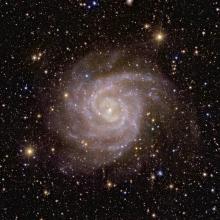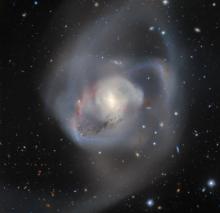Listen to today's episode of StarDate on the web the same day it airs in high-quality streaming audio without any extra ads or announcements. Choose a $8 one-month pass, or listen every day for a year for just $30.
You are here
Triangulum Galaxy
Almost every galaxy is giving birth to at least a few stars. But a giant stellar nursery on the rim of M33, the Triangulum Galaxy, takes starbirth to the extreme. It is giving birth to thousands of stars — including many that are among the hottest, brightest, and most massive yet seen.
M33 is the third-largest member of the Local Group, a collection of scores of galaxies. The Milky Way and the Andromeda Galaxy are its largest members. M33 is about half the diameter of the Milky Way, and contains perhaps one-tenth as many stars.
Several loosely wound spiral arms wrap around its nucleus. The arms contain huge amounts of gas and dust — the raw materials for new stars. Much of it congregates in a collection of stellar nurseries.
The largest is NGC 604. It’s about 6,000 times brighter than the Orion Nebula, the closest major nursery to Earth.
NGC 604 is only a few million years old, but it’s already given birth to about 200 superstars — up to 120 times the mass of the Sun. Many of them will explode.
M33 is about three million light-years away, in the constellation Triangulum, which is low in the east-northeast as night falls. Under especially dark skies, the galaxy is just visible to those with good eyesight. Everyone else needs help to see this busy galaxy.
Script by Damond Benningfield





